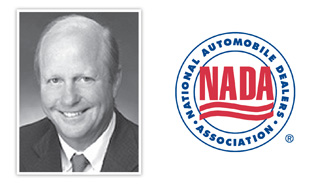NADA Reiterates Warnings of CAFE-Prompted Vehicle Cost Hikes

The National Automobile Dealers Association began a parade of public hearings Tuesday as federal officials continue dialogue about proposed fuel economy rules for model year 2017-2025 passenger cars and light-duty trucks.
Offering his testimony, New Mexico dealer and NADA committee leader Don Chalmers urged federal agencies to properly consider the rising consumer cost of new vehicles.
“To work, fuel economy rules must require improvements that are affordable,” stated Chalmers, who is a Ford dealer and serves as chairman of NADA’s government relations committee.
Chalmers’ declaration came at a joint hearing hosted by the Environmental Protection Agency and National Highway Traffic Safety Administration to discuss Corporate Average Fuel Economy.
“According to EPA and NHTSA, the cumulative cost of all of their fuel economy rules will raise the average price of a vehicle by $3,200. This is not pro-consumer,” Chalmers insisted.
“While EPA and NHTSA can mandate what automakers must build, no one can dictate what customers will buy. If our customers do not purchase these products, we all lose,” Chalmers added.
“NADA supports fuel economy increases as long as they take consumer demand and vehicle choice into account,” he went on to say.
With new-vehicle sales rebounding from a low of 10.4 million in 2009 to 12.7 million last year, Chalmers cautioned that proposed fuel economy standards for the 2017-2025 model year could have real economic consequences if consumer demand is not fully taken into account.
“Dealers embrace the pivotal role we are playing to help lead our nation back to the road of prosperity, but we are wary of anything that might depress auto sales and turn back the gains being made,” he stressed.
In the testimony, Chalmers pointed out that model year 2017-2025 fuel economy rules are not even due until April 1, 2015.
“Rushing to set costly new standards nearly three years early will unnecessarily and unhelpfully forgo the opportunity to learn how consumers react to the aggressive new standards now being put into place,” Chalmers said.
The NADA committee member also questioned the government’s estimated $3,200-per-vehicle price increase as a result of the proposed regulations.
Initial analysis from new research conducted by NADA suggest the federal government’s estimate of $3,200 may be substantially underestimated and the actual cost to consumers may be as high as $5,000.
Chalmers told federal officials that the study will be released in several weeks.
NADA stressed that it intends to raise significant concerns over how the federal government calculated vehicle cost.
Chalmers reiterated from the initial analysis that the administration’s fuel economy proposal grossly underestimates costs and that actual retail prices may increase by as much as 60 percent.
In another study to be released in the coming months, NADA highlighted that it will look back at the EPA’s 2002-2010 medium- and heavy-duty truck emissions mandates, suggesting that the EPA underestimated the average actual compliance costs by a factor of three and that widely recognized market disruptions occurred as a result of fuel-economy rules.
Meanwhile, Global Automakers’ president and chief executive officer Michael Stanton also testified at Tuesday’s hearing.
Stanton reiterated that Global Automakers and its members strongly support a comprehensive and harmonized national approach to reducing greenhouse gas emissions and improving fuel economy.
“The proposed MY2017-2025 regulations bring us a step closer to one national program,” stated Stanton on behalf of the organization that represents manufacturers, original equipment suppliers and other automotive-related trade associations.
“We will continue to work with the agencies to refine the proposed regulations to make them simpler and more flexible, while retaining the intended energy and environmental benefits,” he added.
EPA and NHTSA are holding two more public hearings — one in Philadelphia on Thursday and another in San Francisco next Tuesday. Edmunds.com vice chairman Jeremy Anwyl is scheduled to testify at the California event.
Like NADA, Anwyl is skeptical about what the latest proposed CAFE standards could bring.
“To be fair, I should say it is highly unlikely that higher fuel-economy standards will result in a net increase in jobs. The point being that no one can say with certainty what will or will not happen a decade or more in the future. Heck, it is hard enough to get to a level of confidence about what to expect next year, let alone in 2025,” Anywl said.
“In fact, this strikes me as one reason why Congress was unusually wise when it restricted the National Highway Traffic Safety Administration from setting CAFE standards for no more than five years in the future. Anything further out is really a leap into the unknown,” he went on to say.
Edmunds.com looked to outline all points of the issue as well as historical context. So it put together a question-and-answer section on its website about CAFE, which is available here.
Last summer, President Obama was joined by top executives from a host of automakers who supported the administration’s target of raising the CAFE level to almost 55 miles per gallon by 2025.
Auto Remarketing’s recap of that event and initial analyst reaction can be found here.

 View The Latest Edition
View The Latest Edition

